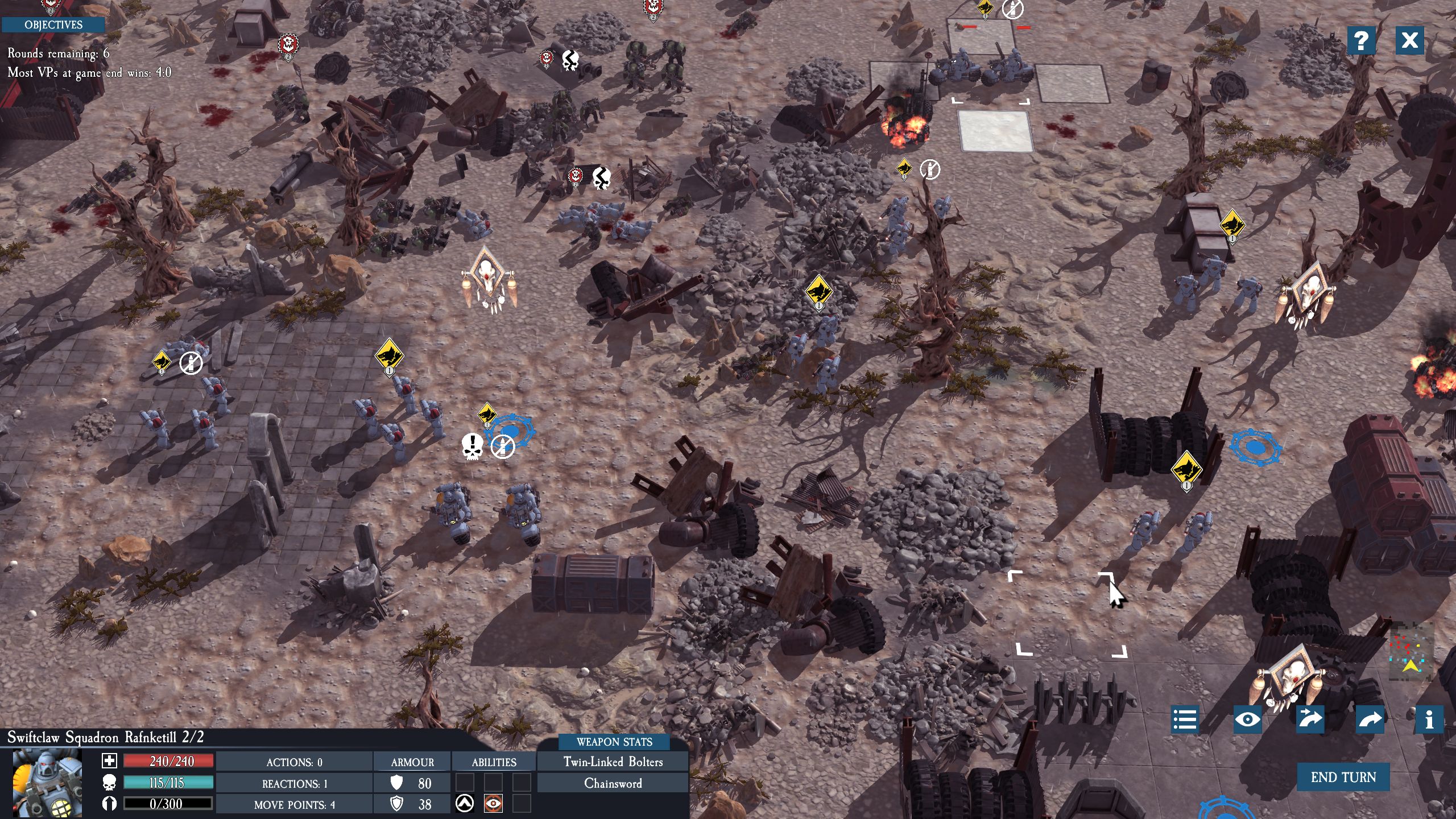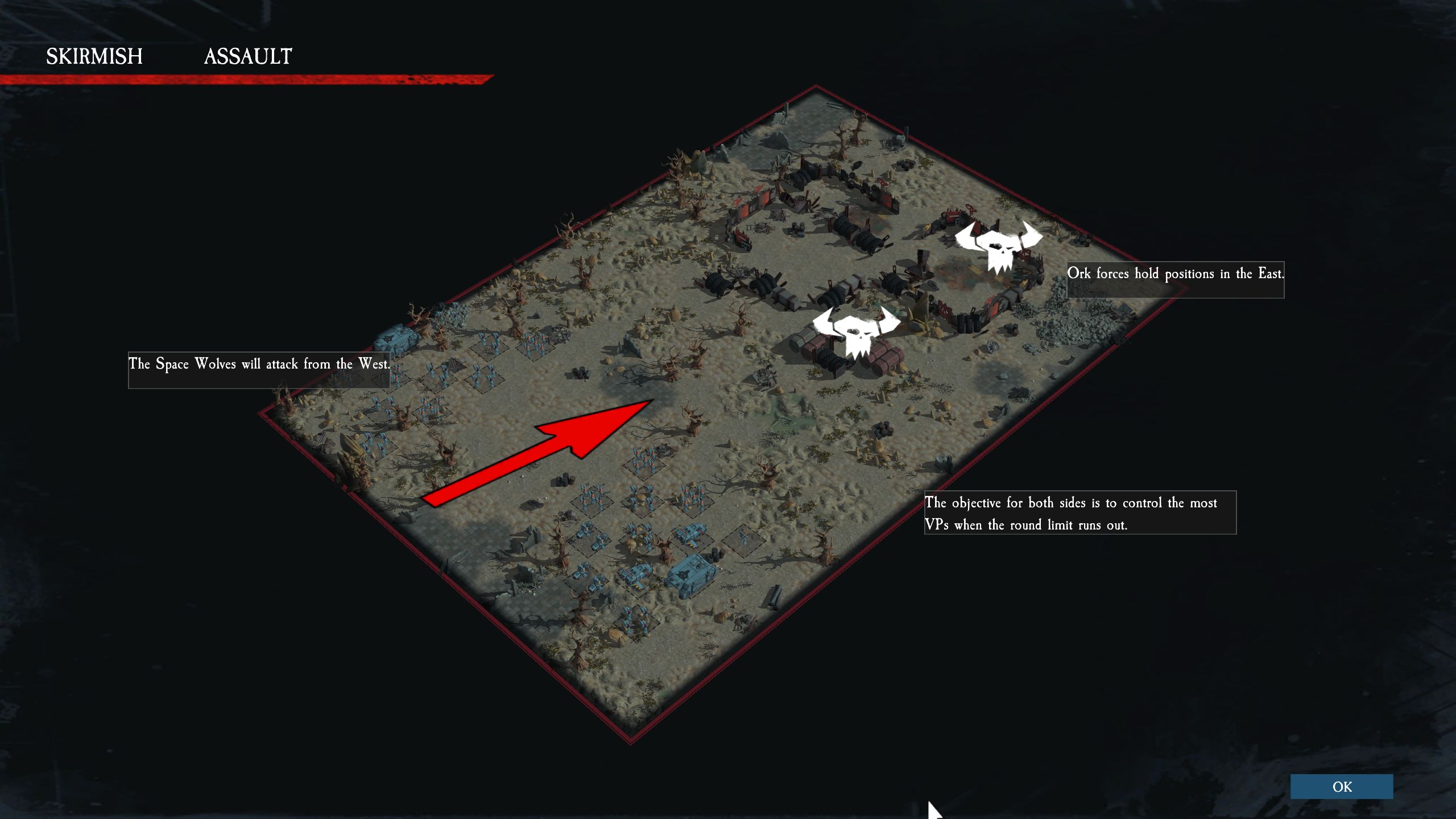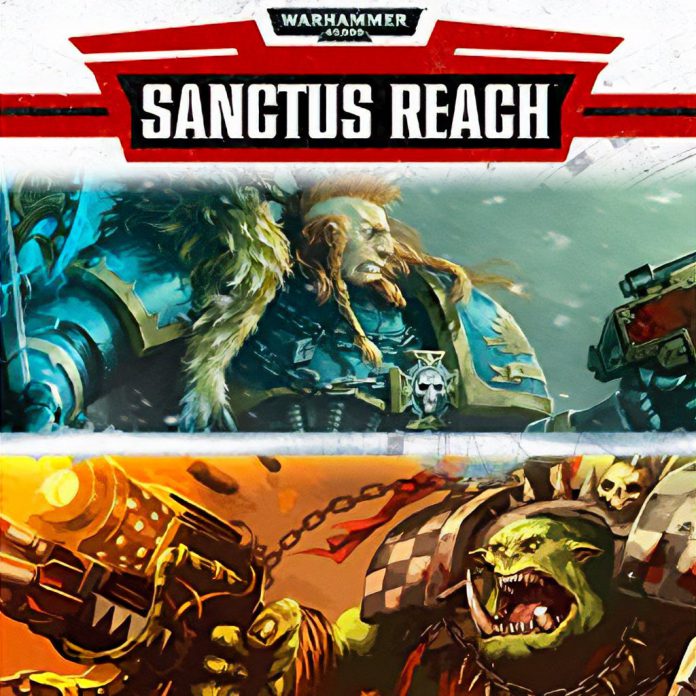With our ongoing look back at Sanctus Reach over in our narrative play coverage, we thought we’d also look at the supporting material that came out with the same branding over the years around the campaign. Today we look at the video game which bears the Sanctus Reach name; on Monday, we’ll take a look at the Black Library contributions to the story of Sanctus Reach.
You might not have known there was a Sanctus Reach game in the Warhammer 40000 library! You’d be forgiven for that. Warhammer 40000: Sanctus Reach is a turn-based grid-based tactical game that runs a very streamlined, very vague adaptation of the version of 40K that you play on the table. It hit the market in January 2017, nearly three years after the seventh edition narrative material whose name it shares; eighth edition wouldn’t hit until that summer, but the final tabletop supplement bearing Sanctus Reach name, Hour of the Wolf, was released in September 2014. You also might not have heard of it — or have swiftly forgotten about it — because it’s not very good.

We’ll start with the positives: In 2017, this was about the best you were going to get if you wanted to play a 40K video game that kinda-sorta felt like 40K. There were a bunch of mobile games out there, one with Deathwatch branding, a couple with Space Hulk, and a Battlefleet Gothic mobile game timed to drop with the real-time strategy Battlefleet Gothic: Armada title, but in terms of an actual for-Windows game with turn-based tactical gameplay where your little mans walked across a map to shoot the other guy’s little mans, this is about it. It does not appear it was ever released on mobile, which is a surprise since the UI/UX is extremely touchscreen friendly, with helpful buttons to press everywhere and a lot of click to select/click to place/click to confirm workflows instead of dragging things or using right mouse button inputs to change behavior (instead, right mouse button is the universal “de-select what you have selected” input). This stuff is fine, as far as it goes, though if you’re used to how most PC RTS and turn-based tactical games handle mouse inputs, it takes some getting used to.
You have movement points, health points, attack points, reaction points. They’re pretty simple and intuitive. If you get behind cover you’re harder to hit. Some guys want to be in melee; some want to be at range. Some do better against vehicles; some are better against infantry. Some light checking reveals that yes, the units in the game roughly correspond to units from the tabletop and do roughly similar things. There is a pretty workable and functional system here if you and a buddy want to play something kinda tabletop 40K-like but don’t have the space or the time (and it’s still the first half of 2017 or something). The sound effect they have for grot laughter is really good. The sound effects in general are very good, but I suspect there’s a library of 40K sounds that these developers are licensing from Relic Entertainment or Games Workshop itself, because it sounds a lot like Dawn of War, which you’d expect. Everything the game sets out to do, it does.

And that’s about the best thing you can say for it. You won’t get the story of Sanctus Reach, even just the part involving the Space Wolves, communicated to you in any significant way; five missions into the Stormclaw campaign, there’s been no attempt at narrative other than the opening cinematic and some terse one-sentence mission descriptions. Checking the tabletop source material, apparently we’re chasing down Warlord Grokk who is mysteriously alive now after supposedly dying in the first leg of the story, but other than Grokk’s name being in the three-sentence description of Stormclaw campaign on the campaign select screen, that hasn’t come up (and nothing about him being back from the dead or whatever).
Other than the Space Wolves howling as the sound effect for a couple special moves, you get nothing flavorful about them despite this basically being their big moment as a chapter for the next decade of narrative play; no scripted dialogue where commanders talk to each other, no screens of text purporting to be battle reports or scribe logs, none of that stuff. Similarly, the grot laughter is literally the best Ork flavor you’ll get in this thing. Maybe there’s a cutscene at the end of these campaigns but the campaigns themselves are just strings of proc-gen skirmishes using the barebones ruleset they’ve built for Sanctus Reach, cycling between a couple different pre-fab mission types. If you remember how obvious it was in the Dawn of War 2 expansions that they were running on fumes and doing less and less bespoke work on the missions for each pack of content that came out, you have the right idea here, except even Retribution had more engaging mission-to-mission gameplay than this because of how campaign-level systems interacted with each tactical map. Very little of that here, beyond the game remembering your units leveling up between maps and giving you some pro forma upgrade paths for them.

The tactical maps themselves are a slog; they’re either generated from pre-created parts or there are a lot of bespoke, very boring maps in here. They’re very cluttered and terrain is very difficult to destroy; some of this is flavor-appropriate, fine, but Space Wolves as a faction need space to stretch their legs, move quickly and get in close. You get Land Raiders and bike-mounted units specifically for this. And yet unless it’s an escort mission — yes, this game has point-to-point escort win conditions; yes, they’re as irritating as that sounds — half the map will be covered in rough terrain and features that block mobility, line of sight, or both. “Half the map” is a slight exaggeration but not a huge one; they really went to town on some of these boards. The boards themselves are also very small to encourage bite-sized fights, but since the computer isn’t constrained by a points-built army size like you are and can just deploy units in from the map edge on a regular basis, it mostly leads to you feeling claustrophobic and out of position at all times.
Contemporary reviews praised the graphics and how well it modelled the units and vehicles of the armies in the game; they’re fine, but they don’t seem so much better than Dawn of War 2’s models that it’s worth writing home about it, and the color palette of the game is just muddy garbage all around. Since this doesn’t really fit anywhere else: I had to turn the music off shortly into my time with Sanctus Reach not because it was generic and repetitive — it is; the game appears to only have one music track — but because there’s an extended section in the piece where it plays nothing but a tinnitus-like whine over some low percussion, which is especially maddening with headphones on.

This far down the line, Warhammer 40000: Sanctus Reach is mostly interesting as a historical artifact in the development of the modern-day Games Workshop tactical turn-based video game. This game walked so games like Mechanicus and Battlesector could run. Battlesector specifically improves on basically everything that went wrong above because it’s the follow-up 40K game from Slitherine, the studio that made Sanctus Reach, and so it actively takes the concepts that Sanctus Reach worked with and makes them more interesting, adds more layered systems on top of them, makes the game look better and feel better and does much better with tactical map design than Sanctus Reach managed.
Final Verdict: At the moment of writing this post, the full collection of Sanctus Reach content is marked down some 70-80% on Steam, allowing you to get the game and all of its expansions for around $20. If you really, really love barebones 40K tactical turn-based play, this is conceivably a good deal, but don’t buy this game in 2025 at anything approaching full price. Go spend that money on any DLC you missed from Battlesector instead.
Have any questions or feedback? Drop us a note in the comments below or email us at contact@goonhammer.com. Want articles like this linked in your inbox every Monday morning? Sign up for our newsletter. And don’t forget that you can support us on Patreon for backer rewards like early video content, Administratum access, an ad-free experience on our website and more.


